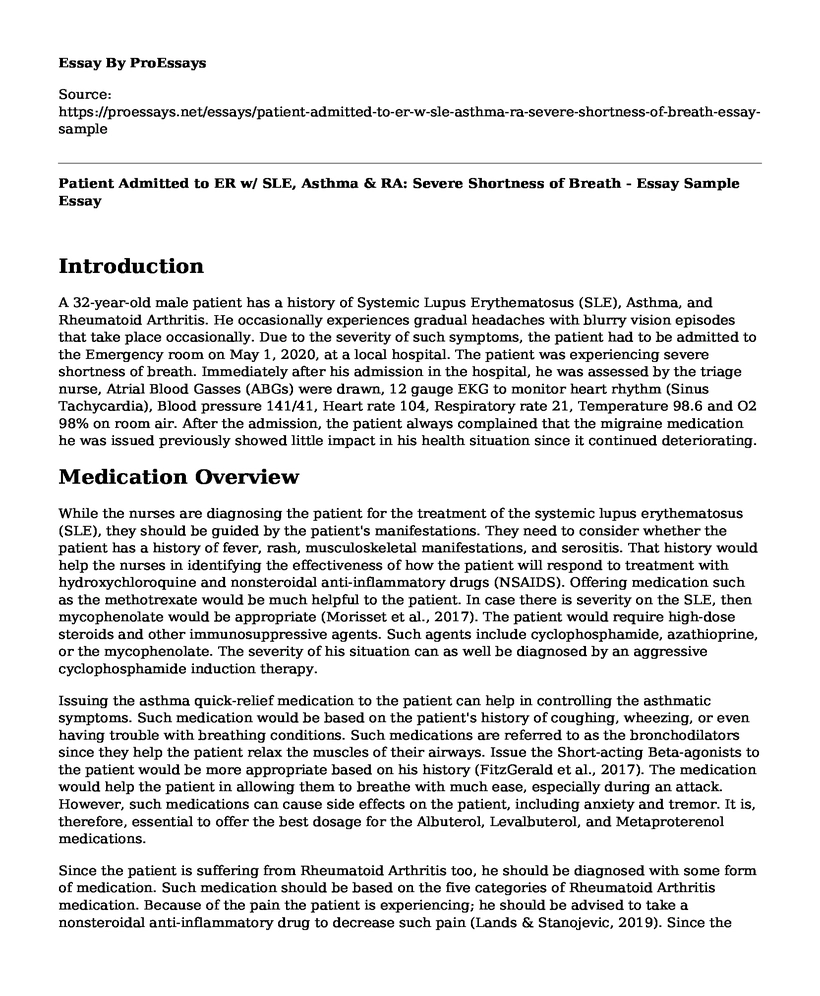Introduction
A 32-year-old male patient has a history of Systemic Lupus Erythematosus (SLE), Asthma, and Rheumatoid Arthritis. He occasionally experiences gradual headaches with blurry vision episodes that take place occasionally. Due to the severity of such symptoms, the patient had to be admitted to the Emergency room on May 1, 2020, at a local hospital. The patient was experiencing severe shortness of breath. Immediately after his admission in the hospital, he was assessed by the triage nurse, Atrial Blood Gasses (ABGs) were drawn, 12 gauge EKG to monitor heart rhythm (Sinus Tachycardia), Blood pressure 141/41, Heart rate 104, Respiratory rate 21, Temperature 98.6 and O2 98% on room air. After the admission, the patient always complained that the migraine medication he was issued previously showed little impact in his health situation since it continued deteriorating.
Medication Overview
While the nurses are diagnosing the patient for the treatment of the systemic lupus erythematosus (SLE), they should be guided by the patient's manifestations. They need to consider whether the patient has a history of fever, rash, musculoskeletal manifestations, and serositis. That history would help the nurses in identifying the effectiveness of how the patient will respond to treatment with hydroxychloroquine and nonsteroidal anti-inflammatory drugs (NSAIDS). Offering medication such as the methotrexate would be much helpful to the patient. In case there is severity on the SLE, then mycophenolate would be appropriate (Morisset et al., 2017). The patient would require high-dose steroids and other immunosuppressive agents. Such agents include cyclophosphamide, azathioprine, or the mycophenolate. The severity of his situation can as well be diagnosed by an aggressive cyclophosphamide induction therapy.
Issuing the asthma quick-relief medication to the patient can help in controlling the asthmatic symptoms. Such medication would be based on the patient's history of coughing, wheezing, or even having trouble with breathing conditions. Such medications are referred to as the bronchodilators since they help the patient relax the muscles of their airways. Issue the Short-acting Beta-agonists to the patient would be more appropriate based on his history (FitzGerald et al., 2017). The medication would help the patient in allowing them to breathe with much ease, especially during an attack. However, such medications can cause side effects on the patient, including anxiety and tremor. It is, therefore, essential to offer the best dosage for the Albuterol, Levalbuterol, and Metaproterenol medications.
Since the patient is suffering from Rheumatoid Arthritis too, he should be diagnosed with some form of medication. Such medication should be based on the five categories of Rheumatoid Arthritis medication. Because of the pain the patient is experiencing; he should be advised to take a nonsteroidal anti-inflammatory drug to decrease such pain (Lands & Stanojevic, 2019). Since the symptoms have been in existence for more than 12 weeks, then the patient should be issued fast-acting steroids, including prednisone. One of the key advantages of being diagnosed with steroids is that they can be injected into the patient's joints. The injection of such steroids will help in reducing the side effects of such medication.
Nursing Implications
The nurses need to offer more interventions for administration monitoring and the effectiveness of the medication. Such interventions need to be offered through:
- Counseling the patient on the importance of meeting the medication instructions.
- Following up on the patient on the way he is administering his medication even after discharge.
- Comparing the pre-packed chloroquine tablets versus chloroquine syrup.
- Encouraging honest and open communication for the patient when experiencing challenges in following the prescriptions.
- Providing positive reinforcement on the importance of adhering to the medication.
- Helping the patient with establishing more effective schedules for the medication.
- Offering terminal care and hospice on the patient.
- Bereavement support in taking the medication.
- Conducting status reports on how effective the patient is adhering to medication.
- Taking universal health precautions on the patient.
Patient Education Plan
The patients assume the responsibility of educating the patient while helping him become more responsible for his health status. One of the education needs is to ensure that the patient takes the proactive care while comprehending their condition. The education would serve as a means of minimizing the patient's complications of the illness. A vital goal of the patient education plan would be to provide the patient with the necessary knowledge about his condition and what they need to know. The patient education plan's objective would be to inform the patient of what he is expected to do if the problems retake place. Another objective for the patient education plan would be informing the patient about the warning signs he is supposed to watch for.
References
FitzGerald, J. M., Tavakoli, H., Lynd, L. D., Al Efraij, K., & Sadatsafavi, M. (2017). The impact of inappropriate use of short-acting beta-agonists in asthma. Respiratory medicine, 131, 135-140.
Lands, L. C., & Stanojevic, S. (2019). Oral nonsteroidal antiinflammatory drug therapy for lung disease in cystic fibrosis. Cochrane Database of Systematic Reviews, (9).
Morisset, J., Johannson, K. A., Vittinghoff, E., Aravena, C., Elicker, B. M., Jones, K. D., ... & Collard, H. R. (2017). Use of mycophenolate mofetil or azathioprine for the management of chronic hypersensitivity pneumonitis. Chest, 151(3), 619-625.
Cite this page
Patient Admitted to ER w/ SLE, Asthma & RA: Severe Shortness of Breath - Essay Sample. (2023, Aug 14). Retrieved from https://proessays.net/essays/patient-admitted-to-er-w-sle-asthma-ra-severe-shortness-of-breath-essay-sample
If you are the original author of this essay and no longer wish to have it published on the ProEssays website, please click below to request its removal:
- Research Paper on Incivility in Nursing
- Clinical and Organizational Problem in Memorial Hospital, Jacksonville Paper Example
- The Bhopal Incident Essay Example
- Literary Analysis Essay on Notes From Underground by Fyodor Dostoyevsky
- Paper Example on Dental Assistants: Essential Members of the Dental Care Team
- Essay Example on Diabetes: A Growing Health Risk in the U.S.
- Paper Example on Organization's Performance Metrics







